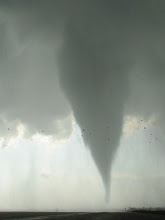I've completed a modified sounding, shown below, mainly in order to illustrate the role of elevated terrain (which I believe to have been considerable) in this case. Despite semi-borderline-low dewpoints for a cold core event (upper 40s F)... as well as very modest surface heating amidst localized cloud breaks to the cool side of the boundary (low 50s immediately ahead of the surface low)... this sounding still cranks out relatively ridiculous levels of instability! MLCAPE of over 700 J/kg and 0-3 km MLCAPE of 120 J/kg is mighty impressive considering the meager low-level theta-e... and that is strongly attributed to the elevation in far southwest KS (near 3300 ft MSL). If a surface parcel is lifted (which Jon Davies recommends for monitoring cold core tornado events IIRC), the instability numbers are even more outrageous!
As impressive as the conditions were in far southwestern KS, they became unfavorable for strongly surface-based convection pretty quickly as one moved eastward to gradually lower terrain (e.g. toward Garden City). Heating to the cool side of the boundary was negligible farther east with a lack of breaks in the dense stratus. Regardless, even if areas there had cleared and heated similarly into the lower 50s, the capping inversion (sampled by the 00Z DDC RAOB) still may not have broken due to modest low-level theta-e and lower elevations. In hindsight, it's not surprising that convection with the upper level low was pretty much tied to the most elevated terrain farther west, while cells to the east struggled to break the cap... though it should be noted that a plume of elevated instability was in fact present well to the east, based above the surface stable layer (per DDC RAOB).
The modified sounding that follows is from the NAM, which was all that was available to me in NSHARP (the best sounding software on the planet) by the time I got to work today; turns out this would work okay to modify since the pressure surface of the sounding--875 mb--was appropriate for Johnson, KS based on the relative elevations and observed pressure surfaces at AMA and DDC. The NAM sounding itself looked pretty crummy, and I substituted a blend of the 00Z DDC and AMA RAOBs alongside a couple online RUC soundings I'd saved from GSD... with minor modifications to the boundary layer based on Mike's observations during his chase. The result should be quite close to reality.

I haven't messed with constructing a hodograph for this case yet...may do that later. The DDC RAOB indicated fairly impressive 0-1 km SRH of 175 m2/s2 for cells moving N at ~15 kts, but the low-level hodograph there is probably a little too large to be representative. Cold core tornadoes in close proximity to surface lows usually have fairly modest low-level shear, but this case may've been an exception with 0-1 km SRH probably AOA 100 m2/s2.

No comments:
Post a Comment